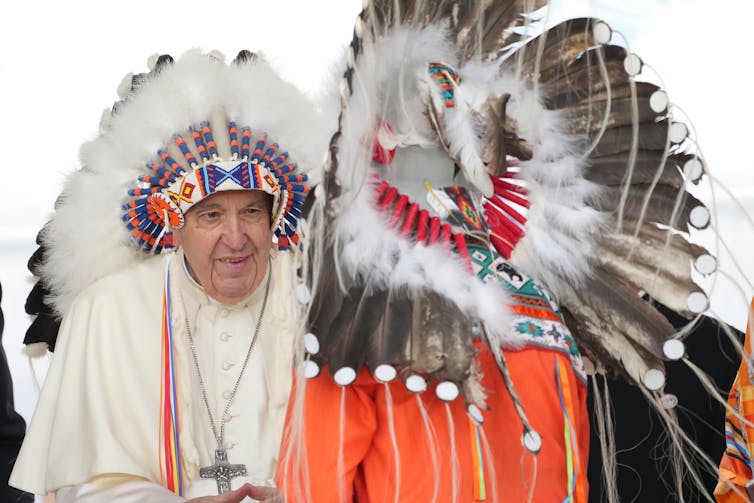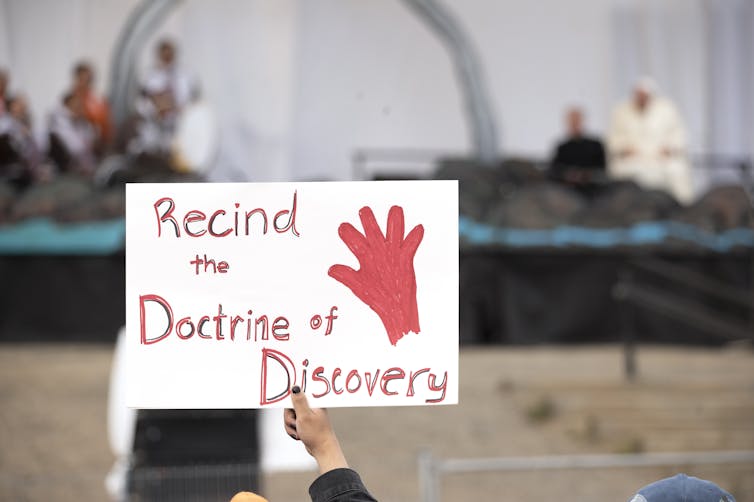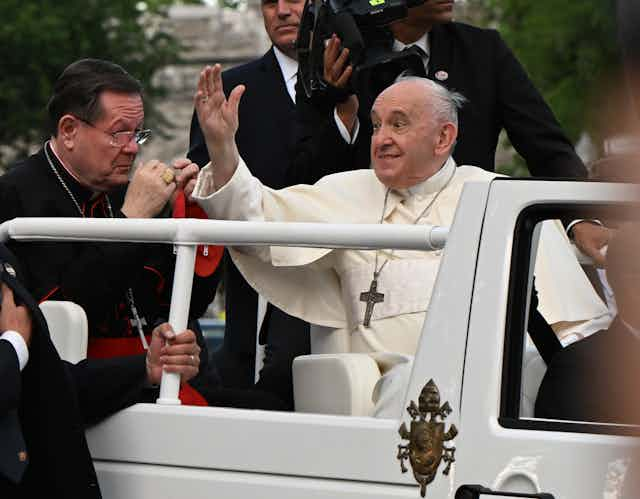Reactions to Pope Francis’s apology in Canada for harm perpetrated by members of the Catholic Church on children at Indian Residential Schools were far from unanimous.
While some have acknowledged the apology was genuine and deeply felt, there was tension and a mix of welcome reception and protest.
Evelyn Korkmaz, a survivor of St. Anne’s Indian Residential School in Ontario, expressed the tension well:
“I had my ups and downs, my hurrays, my disappointments… my wanting more and not getting it. I’ve waited 50 years for this apology and finally today I heard it… Part of me is rejoiced, part of me is sad, part of me is numb, but I am glad I lived long enough to have witnessed his apology. But like I said I want more, because 50 years is too long to wait for an apology.”
The Pope’s visit to Canada, despite being met with reception and protest, was significant. Visiting Indigenous people on their land was a step in the right direction, but the visit was full of tensions — both from what was said and what wasn’t.
Meeting on Indigenous land
In late March an Indigenous delegation from Canada visited the Pope. And last week, the Pope met with Indigenous people on their land, in their homes.
The Pope, representing the Catholic Church, coming to what we now call Canada was significant. He came, as he said, on a “penitential pilgrimage” to encounter, to listen, to apologize.
The Anishinaabe speak of this as entering one another’s lodge — done in an effort to understand each other’s way of being and acting in the world.

The encounter with Pope Francis was full of tensions, in part healing for survivors and their families and in part triggering deep wounds from a traumatic past.
These tensions were illustrated during Cree woman Si Phi Ko’s protest. After former Truth and Reconciliation commissioner Chief Wilton Littlechild placed a headdress on the Pope’s head, Phi Ko could not be silent as she saw it as a sign of disrespect. But for Chief Littlechild, Pope Francis choosing to visit his territory was an honour.
This tension, poles of reception and protest was evoked not only from what was said by Pope Francis in his apology, but by what was omitted.
What was omitted
While recognizing the importance of the apology, former TRC commissioner Murray Sinclair saw a “deep hole” in it.
Sinclair said the Catholic Church’s role in the cultural genocide of Indigenous Peoples was more than just the work of a few bad people, adding it was:
“A concerted institutional effort to remove children from their families and cultures, all in the name of Christian supremacy. While an apology has been made, that same doctrine is in place.”
This doctrine Sinclair is referring to is the Doctrine of Discovery. The Doctrine of Discovery is a legal framework that justified acts like the colonization of North America and its roots are in a series of papal statements. Over the course of the Pope’s visit, many called for it to be rescinded.
As Sinclair mentioned, the church played a role in the cultural genocide of Indigenous people, which is something the Pope failed to acknowledge until he was on the plane home. “I didn’t use the word genocide because it didn’t come to mind but I described genocide,” Francis said.

What was also omitted, in some instances, was the presence of survivors — from the procession to sitting in the front seats during the eucharist, both in Edmonton and at Sainte-Anne-de-Beaupré. Indigenous symbols and ceremonies were also omitted from the altar and during the service.
While Pope Francis sincerely sought reconciliation, reconciliation did not seem to touch these forms of celebration and the clash of cultures was palatable.
Tensions stretched wide
There are also tensions within the Catholic Church itself that were reflected during the papal visit. The tension is between what philosopher Bernard Lonergan calls “classism” and “historical mindedness.”
The Catholic Church as an institution has not adopted a framework that can come to terms with its role in the spiritual, sexual, cultural, emotional and physical abuse suffered by Indigenous children at Indian Residential Schools.
This was clear through the lack of sensitivity to Indigenous cultures during the eucharist and the presence of cardinals, bishops and clergy in the first rows that, at times, obscured the fact that the visit was meant to be an encounter with Survivors and Indigenous communities.
As many said during the Pope’s visit, healing must take place within both parties.
Healing for Indigenous Survivors will constitute both an interior and exterior journey. Healing within the Catholic Church must constitute a reappropriation of truth and value in face of all evil it has been part of.

